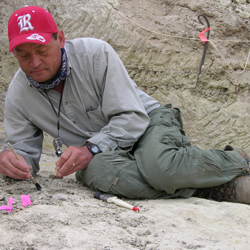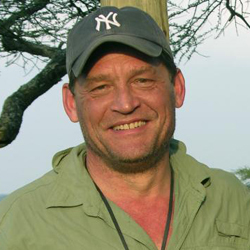Rutgers Anthropologist Leads Project Cataloging Scientific Finds on What Makes Us Human
First multi-discplinary research to occur since fossils of early man were discovered 50 years ago

For more than two decades, Rutgers anthropology professor Robert Blumenschine and a team of scientists have been conducting research at one of the most important prehistoric sites in the study of human evolution to try and answer that question.
As lead guest editor of a 191-page Journal of Human Evolution special issue, he, along with more than two dozen scientists, discussed the discoveries made in the past 20 years that deal with various aspects of Homo habilis, the earliest ancestor of modern humans known to make and use tools and exhibit meat-eating behaviors.
“Our ultimate goal has been to understand how and why we became human,” said Blumenschine, who along with 25 scientists recently cataloged and published results of the first systematic, multidisciplinary research to occur since British scientists Louis and Mary Leakey discovered the fossils of early man more than 50 years ago.
“More specifically we want to know how we became such odd creatures with large brains, being totally dependent on technology for survival and being, in modern times, alpha predators in almost all ecosystems, despite having evolved from largely vegetarian primate ancestors.”
Blumenschine has co-directed the Olduvai Landscape Paleoanthropology Project (OLAPP) in Olduvai Gorge in Tanzania since 1989. His work on carnivore feeding behavior in the Serengeti of Tanzania has provided insight on the long-debated hunting and scavenging issue in human evolution. By reconstructing Olduvai’s ancient landscapes and the activities of the earliest stone

“The significance of this special issue is the culmination of the work we have been doing at Olduvai over the past two decades,” said Blumenschine. “No one site tells us more about the last two million years of human evolution than Olduvai.”
The work being done at the ancient site in the Olduvai Gorge is allowing scientists to piece together a story of our early human ancestors. “It’s like tracing one’s family genealogy,” Blumenschine said. “It’s great to know your great-great grandparents’ names, and wonderful to find a picture of them. But what is really special is to find out how they made a living, what they liked and disliked and what make them tick.”
The archaeological and anthropological research conducted by the OLAPP scientists have found that the activities of early man were concentrated along wooded strips bordering rivers and lakes that could provide them with plant food as well as the leftovers from predator meals. There is no proof that they had a home base, as believed by the Leakeys and many other researchers, but instead were on the move, attracted to fresh water marshes where they could scavenge the meat of the prey animals that came to drink. Making certain they did not become prey while foraging for food and scavenging animal carcasses was a major factor in shaping the behavior and adaptation of early man, Blumenschine said.
Media Contact: Robin Lally
732-932-7084, ext.652
E-mail: rlally@ur.rutgers.edu